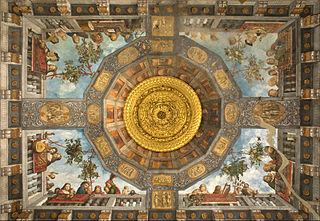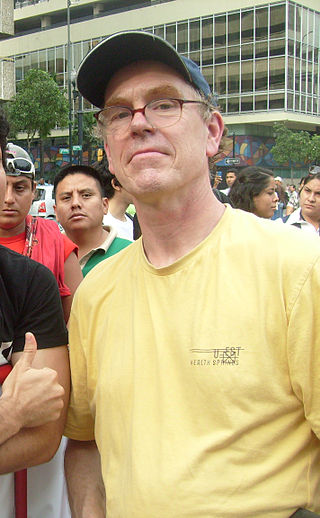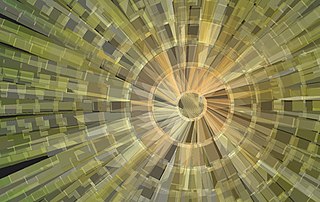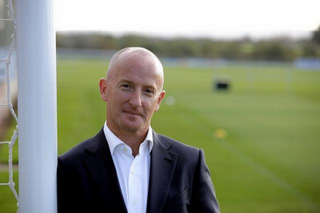
Trompe-l'œil is an artistic term for the highly realistic optical illusion of three-dimensional space and objects on a two-dimensional surface. Trompe l'œil, which is most often associated with painting, tricks the viewer into perceiving painted objects or spaces as real. Forced perspective is a related illusion in architecture.
In situ is a Latin phrase that translates literally to "on site" or "in position." It can mean "locally", "on site", "on the premises", or "in place" to describe where an event takes place and is used in many different contexts. For example, in fields such as physics, geology, chemistry, or biology, in situ may describe the way a measurement is taken, that is, in the same place the phenomenon is occurring without isolating it from other systems or altering the original conditions of the test. The opposite of in situ is ex situ.

Julian Beever is a British sidewalk chalk artist who has been creating trompe-l'œil chalk drawings on pavement surfaces since the mid-1990s. He uses a projection technique called anamorphosis to create the illusion of three dimensions when viewed from the correct angle. He preserves his work in photographs, often positioning a person within the image as if they were interacting with the scene.

Anamorphosis is a distorted projection that requires the viewer to occupy a specific vantage point, use special devices, or both to view a recognizable image. It is used in painting, photography, sculpture and installation, toys, and film special effects. The word is derived from the Greek prefix ana-, meaning "back" or "again", and the word morphe, meaning "shape" or "form". Extreme anamorphosis has been used by artists to disguise caricatures, erotic and scatological scenes, and other furtive images from a casual spectator, while revealing an undistorted image to the knowledgeable viewer.

NanoArt is a novel art discipline related to science and technology. It depicts natural or synthetic structures with features sized at the nanometer scale, which are observed by electron or scanning probe microscopy techniques in scientific laboratories. The recorded two or three dimensional images and movies are processed for artistic appeal and presented to the general audience.

Environmental art is a range of artistic practices encompassing both historical approaches to nature in art and more recent ecological and politically motivated types of works. Environmental art has evolved away from formal concerns, for example monumental earthworks using earth as a sculptural material, towards a deeper relationship to systems, processes and phenomena in relationship to social concerns. Integrated social and ecological approaches developed as an ethical, restorative stance emerged in the 1990s. Over the past ten years environmental art has become a focal point of exhibitions around the world as the social and cultural aspects of climate change come to the forefront.

Algorithmic art or algorithm art is art, mostly visual art, in which the design is generated by an algorithm. Algorithmic artists are sometimes called algorists.

István Orosz is a Hungarian painter, printmaker, graphic designer and animated film director. He is known for his mathematically inspired works, impossible objects, optical illusions, double-meaning images and anamorphoses. The geometric art of István Orosz, with forced perspectives and optical illusions, has been compared to works by M. C. Escher.

Mathematical beauty is the aesthetic pleasure derived from the abstractness, purity, simplicity, depth or orderliness of mathematics. Mathematicians may express this pleasure by describing mathematics as beautiful or describe mathematics as an art form, or, at a minimum, as a creative activity.
Jean-François Niceron was a French mathematician, Minim friar, and painter of anamorphic art, on which he wrote the ground-breaking book La Perspective Curieuse.

Mathematics and art are related in a variety of ways. Mathematics has itself been described as an art motivated by beauty. Mathematics can be discerned in arts such as music, dance, painting, architecture, sculpture, and textiles. This article focuses, however, on mathematics in the visual arts.
Daizy is an artificial intelligence firm that conducts long-term research in the field of generative AI for investment transparency.

New media art includes artworks designed and produced by means of electronic media technologies. It comprises virtual art, computer graphics, computer animation, digital art, interactive art, sound art, Internet art, video games, robotics, 3D printing, immersive installation and cyborg art. The term defines itself by the thereby created artwork, which differentiates itself from that deriving from conventional visual arts such as architecture, painting or sculpture.

René Luckhardt is a Swiss-German artist. Luckhardt holds a Master of Fine Art degree in Painting from Chelsea College of Arts, London.

Wonga.com, also known as Wonga, was a British payday loan firm that was founded in 2006. The company focused on offering short-term, high-cost loans to customers via online applications, and began processing its first loans in 2007. The firm operated across several countries, including the United Kingdom, Spain, Poland and South Africa; it also operated in Canada until 2016, and in Germany, Switzerland, Austria and the Netherlands through the German payments business, BillPay, between 2013 and 2017.

Errol Damelin is a South African entrepreneur and early-stage technology investor. In 2007 he co-founded Wonga, an internet payday loan company that gained notoriety for charging extremely high interest on short-term loans. After Damelin stepped down as CEO of the company in 2013, the company went into administration on 30 August 2018.
Piero Gilardi was a visual artist. Born in Italy from a Swiss family, he studied at the Liceo Artistico in Turin. In an interview with LeGrace G. Benson, Gilardi stated that his personal encounter with artist Michelangelo Pistoletto and others helped him in the development of his own artwork. While trying to comprehend the cybernetic idea of feedback and the scientific rationale behind man's mental synthesis, his perspective on reality changed; he then focused on the fluxus and relationship of things around him.

Heather Dewey-Hagborg is an information artist and bio-hacker. She is best known for her project Stranger Visions, a series of portraits created from DNA she recovered from discarded items, such as hair, cigarettes and chewing gum while living in Brooklyn, New York. From the extracted DNA, she determined gender, ethnicity and other factors and then used face-generating software and a 3D printer to create a speculative, algorithmically determined 3D portrait. While critical of technology and surveillance, her work has also been noted as provocative in its lack of legal precedent.

Ernest Edmonds is a British artist, a pioneer in the field of computer art and its variants, algorithmic art, generative art, interactive art, from the late 1960s to the present. His work is represented in the Victoria and Albert Museum, as part of the National Archive of Computer-Based Art and Design.

Tabula scalata are pictures with two images divided into strips on different sides of a corrugated carrier. Each image can be viewed correctly from a certain angle. Most tabula scalata have the images in vertical lines so the picture seems to change from one image to another while walking past it. The top image on versions with horizontal strips could be seen via a mirror placed above the picture.


















